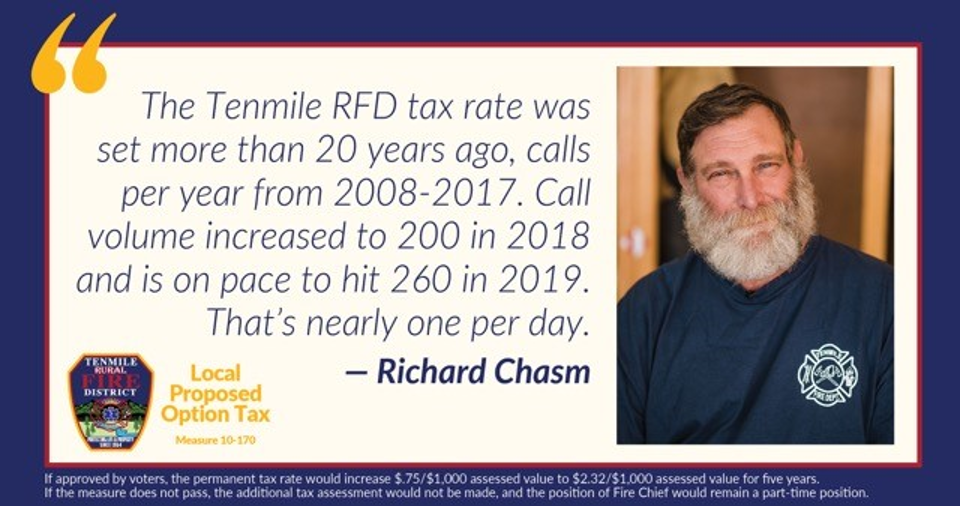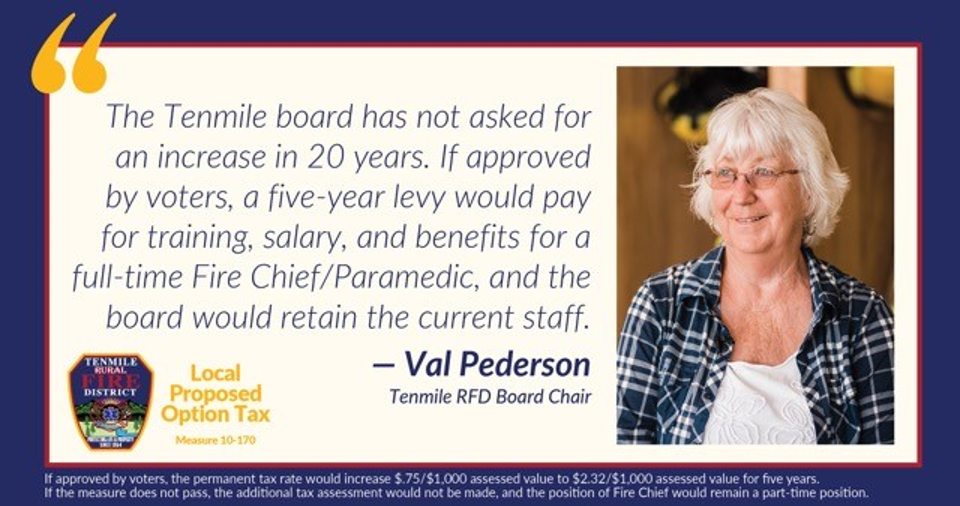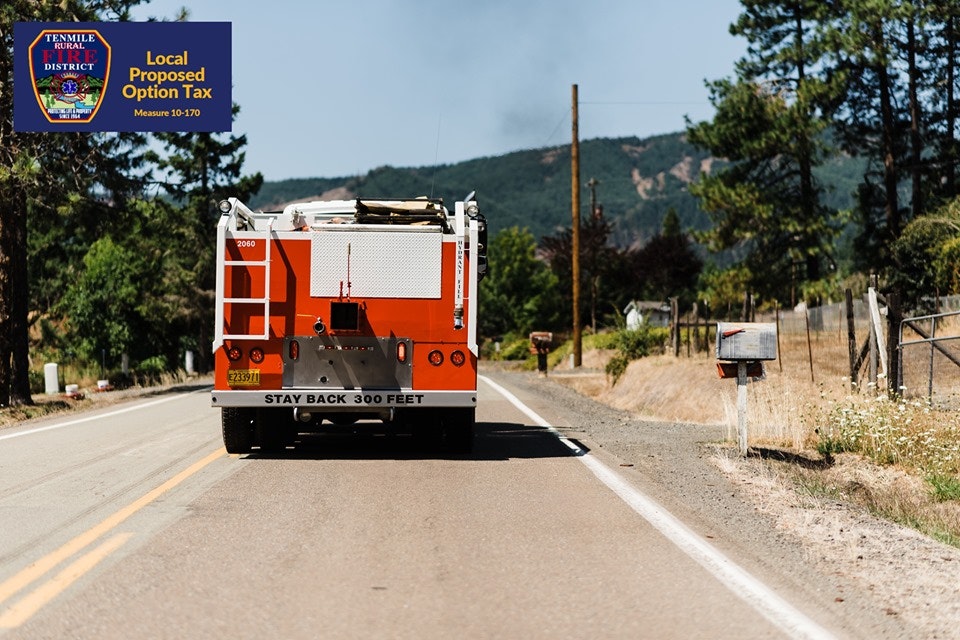Tenmile Fire District Local Proposed Option Tax
On November 5, 2019 voters in the tenmile Rural Fire District will vote on a proposed local option tax which, if approved, would provide funds to hire a full-time Fire Chief/Paramedic in July 2020. If Passed, the levy would raise $68,000-$70,000/per year for five years, which will be used to pay for the training, administrative costs, and salery. If approved by voters, the permanent tax rate would increase $.75/$1000 assessed value to $2.32/$1000 assessed value for five years.
If approved by voters, the average taxpayer in the Tenmile Rural Fire District would pay $15 per month or $0.50 cents per day based on a $225,000 home, the median home value in the district.
If the measure does not pass, the additional tax assessment would not be made, and the position of Fire Chief would remain a part-time, as available position.
levy video.mp4PROPOSED TAX LEVY QUESTIONS AND ANSWERS
• How is the Fire District managed?
The Fire Chief is under the jurisdiction of the Board and the regulations and requirements of State and Federal laws and governing bodies. The Board members are elected officials who were elected by a vote of the people in the District. The Board holds a meeting every month. Each meeting is advertised in advance and is always open to the public with a section reserved on the agenda for audience participation. Each meeting includes a complete monthly financial report and fire chief report as well as other items on the agenda. The annual budget process is open to the public. The proposed budget is advertised in the News Review and posted at the Tenmile Fire Station and the Tenmile Store. A Final Public Hearing is held in June before the proposed budget is adopted.
Additionally, the District has an annual audit review performed by a certified public accountant and is held under the jurisdiction of the Oregon Department of Revenue, the Secretary of State, Special District’s Association and Special District Insurance Services.

• How is the District funded?
The permanent tax rate for Tenmile Fire was set twenty years ago and has not changed. The Board manages the day-to-day operations of the District within the annual operating budget. Th District has no debt and maintains a reserve account for equipment replacement and provides funds for equipment and training staff.
• Could the District be managed by either Winston-Dillard (W-D) Fire District, Camas Valley Fire District or Doug 2 Fire District?
The permanent tax rate (PTR) for W-D Fire is $4.6453 per $1,000 of assessed value. The PTR for Doug 2 Fire is $3.1651 per $1,000 of assessed value. The PTR for Camas Valley Fire District is $3.28 per $1,000 of assessed value. The PTR for Tenmile Fire is $1.5689 per $1,000 of assessed value. If another district managed Tenmile Fire, the PTR would increase to their PTR. If Doug 2 managed the District the average taxpayer would pay an additional $359.00 in annual property tax based on an average home assessment of $225,000. If W-D Fire managed the District the average taxpayer would pay an additional $692.00 in annual property tax based on an average home assessment of $225,000. If Camas Valley Fire District managed the District the average taxpayer would pay an additional $738 in annual property tax based on an average home assessment of $225,000.
• What services would be provided by a Paramedic compared to an EMT?
The differences between an EMT and a Paramedic are primarily in the training and in the scope of practice. Basic EMT’s receive 120-150 hours of training. Paramedics receive 1,200-1,800 hours of training. Paramedics an administer shots, start intravenous lifelines, perform cardiac monitoring and 12-lead EKG monitoring and interpretation, cardiac pacing and synchronized cardioversion for lethal cardiac rhythms, I.V., I.O., I.M. access for meds, advanced airways, including chemically sedated and paralyzed intubations and surgical airways, and administer 30-40 additional medications – all of which EMT’s are not allowed to do. 78% of the District’s call volume consists of medical runs, motor vehicle accidents and a small number of public assists.

• If the measure passes, how would funds be used?
W-D Fire servs a 52 square mile area and responded to 2,000 calls per year last year with one ambulance. If they are responding to another call, they are not available to assist in our District, so the ambulance would come out of Doug 2 from its Green fire station. If the measure passes and a full-time chief is hired, the fire chief in Tenmile would work within the District.
• Do regulations require a minimum of two people on runs?
78% of the District’s call volume is made up of medical, motor vehicle accidents, and public assist runs which do not require more than one person for response. Entry of a structure fire does require a minimum of two personnel.
• Why was the measure submitted to voters?
Call volumes reached 200 calls in 2018. TRFD is on pace to receive 260 calls in 2019, which is a 62% increase over the call volume during the decade beginning in 2008. Most of the District’s volunteers, including the fire chief, have full-time jobs and are not always available to respond.
• What would be the fiscal impact of the measure?
If the tax levy passes, it would cost the average taxpayer in the District $15.00 a month or $0.50 per day based on the average home assessment of $225,000.
• If the measure passes, what would the fire chief’s schedule be?
The fire chief would work full-time and would be at the Tenmile Fire Station or in District on a regular schedule, as well as being available on-call.

• If the measure passes, how would funds be used?
The proposed salary package would include a monthly salary, health insurance, a retirement plan and the employer’s share of Social Security and Medicare, together with a paid vacation. If the tax levy is successful, funds would be used to pay for the salary, administration and training of a full-time fire chief/ paramedic, and not be used for any other purposes.
• How would the District’s goals be set?
An improvement plan was implemented in June, 2018 and is reviewed and updated regularly. A semi-annual report is given to the Board by the fire chief.
• If the measure passes, would the District hire additional staff?
The District has no plans to hire any additional full-time employees, nor to submit additional measures to the voters for additional taxes. If a fire chief is hired, this would have no effect on the District’s non-profit status.
The district currently pays a monthly stipend to the fire chief, the assistant chief, training officer and maintenance officer. Volunteers are paid a stipend based on the individual participation in runs and training.
If Measure 10-170 is approved by voters, the permanent tax rate would increase $.75/$1,000 assessed value to $2.32/$1,000 assessed value for five years. If the measure does not pass, the additional tax assessment would not be made, and the position of Fire Chief would remain a part-time position






